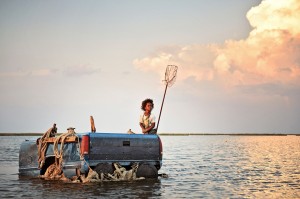Annie
Posted on December 18, 2014 at 5:59 pm

The story of the plucky little Depression-era orphan with the curly red hair has been not just re-booted but re-imagined into the world of rent-a-bikes, viral videos, DNA tests, YOLO, corporate privacy invasions, and Katy Perry tweets. There are some nice shout-outs to the original version, with a character named for Little Orphan Annie creator Harold Gray and a music group named the Leapin’ Lizards after the redhead’s favorite way to express surprise.
A cheeky opening briskly bridges the decades. It begins with a red-headed girl named Annie giving a school report, concluding with a tap dance. She looks like the Annie we remember. But then the teacher calls on another Annie, and we meet our Annie, played by “Beasts of the Southern Wild’s” Quvenzhané Wallis. She gives a rollicking report about Franklin Roosevelt and the New Deal that sounds like a call to action from Occupy Wall Street. The whole classroom bangs on their desks along with her. Annie is all about the 99 percent. (The famously very right-wing Gray would be horrified.)
And, as she repeatedly reminds us, she is not an orphan. She is a foster kid. Every Friday evening, she waits outside the restaurant where her parents were last seen, in hopes that they will return. She was four when they left her with a note and half of a locket, and since then she has gone from foster home to foster home, now living with Miss Hannigan (Cameron Diaz), a bitter, abusive, alcoholic woman who once sang with C&C Music Factory and was almost a Blowfish. She resents the girls who are her only source of income, and makes them do all the work in the apartment.
Will Stacks (Jamie Foxx) is a cell phone company billionaire running for mayor of New York. (That’s “Stacks” as in “stacks of money,” with “Warbucks” a bit too on the nose for our more euphemistic times.) When he grabs Annie to save her from getting hit by a truck, his approval numbers spike, and his aides encourage him to spend some time with her to give him a more relatable image. Grace (Rose Byrne) is his all-purpose, super-efficient second-in-command and Guy (Bobby Cannavale) is his whatever-it-takes spin-master campaign advisor. Annie, about to be thrown out by Miss Hannigan, persuades Stacks to let her stay in his mega-luxurious apartment, promising that her “game face” will get him good press, combating his image as “a rich elitist who can’t relate to regular people.”
It works for a while until some unscrupulous people hire a couple to pose as Annie’s real parents.
Some of the updates work well, and there is a nice energy in the opening scenes as Annie uses the last ten minutes of a bike share to navigate the city, passing street performers riffing on the well-known score. Co-writer/director Will Gluck keeps things bright and bouncy, but his filming of the dance numbers is clumsy to the point of incompetence, undermining even the nearly unkillable numbers like “It’s a Hard Knock Life” with angles and edits that take the energy out of the songs instead of boosting it.
Wallis is inconsistent, occasionally appearing checked out of the scene. She is better in the few scenes with the other girls, but she has very little chemistry with Byrne or Foxx. And one barfing scene is bad, but four? Plus a spit take? And a hooker joke? There is a movie-within-the-movie that is very cute, but the cameos are a distraction. The tweaking of the script works better in individual scenes than in the overall plot, which feels slapped together and unsatisfying. Ah, well, the sun will come out tomorrow, so maybe next time they’ll get it right.
Parents should know that this movie has themes of child abandonment and abuse, a character abuses alcohol and there is a joke about alcoholism, and there is some mild peril and potty humor.
Family discussion: What did Annie mean when she said Stacks did not know he was good yet? How is Annie different from the other girls?
If you like this, try: the other musical versions and “Game Plan”



